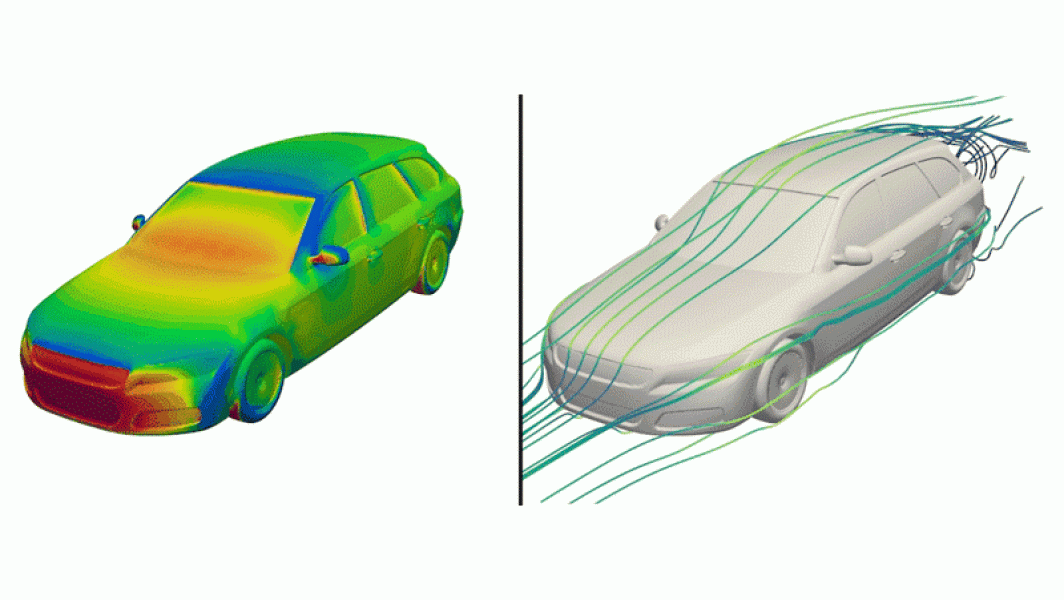
(Photo courtesy of Mohamed Elrefai)
Engineers at MIT have developed over 8,000 electric vehicle (EV) designs that can be integrated with artificial intelligence (AI) to quickly create the cars of the future.
The open database, called “DrivAerNet++,” includes designs based on the most common types of cars in use today, engineers say, in the form of 3D models that contain information on aspects such as the aerodynamics of the design.
Electric cars have been around for over a century, but their popularity has exploded in recent years. The process of developing such cars takes companies many years, resources, iterations, and improvements before they reach a final design that can be used to create a physical prototype.
Because of their proprietary nature, the specifications and results of these tests (including the aerodynamics of the prototypes) remain confidential. This means that significant advances in EV range or fuel efficiency may be slow to come, the scientists note.
However, the new database is designed to significantly speed up the search for optimal vehicle designs.
This digital library of car designs contains detailed data on specifications and aerodynamic characteristics. The researchers said that the library could be used to develop new electric vehicle designs if combined with AI models in the future.
Engineers noted that by streamlining the lengthy process, manufacturers will be able to develop electric vehicle projects faster than ever before.
The team submitted a paper, uploaded to the arXiv preprint database on June 13, describing the dataset and its potential for integration with AI technologies. They also presented the work at the NeurIPS conference in Vancouver in December.
Using AI to Design a Car in Seconds
The dataset the researchers created is 39 terabytes in size and requires 3 million CPU hours of processing power using the MIT SuperCloud, a powerful cluster of computers that is accessible remotely for scientific research.
The team used an algorithm that systematically adjusted 26 parameters, including the length of the car, the underbody features, the shape of the tread and wheels, and the angle of the windshield for each base model car. They also ran an algorithm that determined whether a new design was a copy of an existing one or truly original.
Each 3D design was then converted into a variety of readable formats — including a mesh, a point cloud, or simply a list of dimensions and specifications. Finally, complex fluid dynamics simulations were run to calculate how air would flow around each generated design.
“The process of direct upgrades is so expensive that manufacturers can only slightly modify a car from one version to the next,” Faez Ahmed, an associate professor of mechanical engineering at MIT, said in a statement. “But if you have large data sets where the performance of each design is known, you can train machine learning models to iterate quickly, increasing the chances of getting a better design.”
Mohamed Elrefai, a mechanical engineering student at MIT, said the dataset could help reduce research and development costs and speed up progress. He added that speeding up the design process would also be good for the climate if it led to more efficient vehicles that reached consumers faster. The key to speeding up design is integration with AI tools. The dataset allows a generative AI model to be trained “to perform tasks in seconds rather than hours,” Ahmed added.
Previously, AI models could generate seemingly optimized designs, but they were based on limited training data.
The new dataset provides more robust training data that AI models can now use to create new designs or test the aerodynamic performance of existing ones. This data can be used to calculate the efficiency and range of an EV without the need to build a physical prototype.

Andrea Saravia Perez Social Links Navigation
Andrea is a journalist, founder, and multimedia writer. She is passionate about truth-seeking and loves to explore the intersection of technology and storytelling, which has led her to specialize in covering breakthroughs in virtual and mixed reality, sustainable technologies, and how contemporary artists are applying science and engineering to their work. Her work has appeared in DBLTAP, Cheat Code Central, Contxt, Shift: A Literary Journal, and Chomp.
Sourse: www.livescience.com





